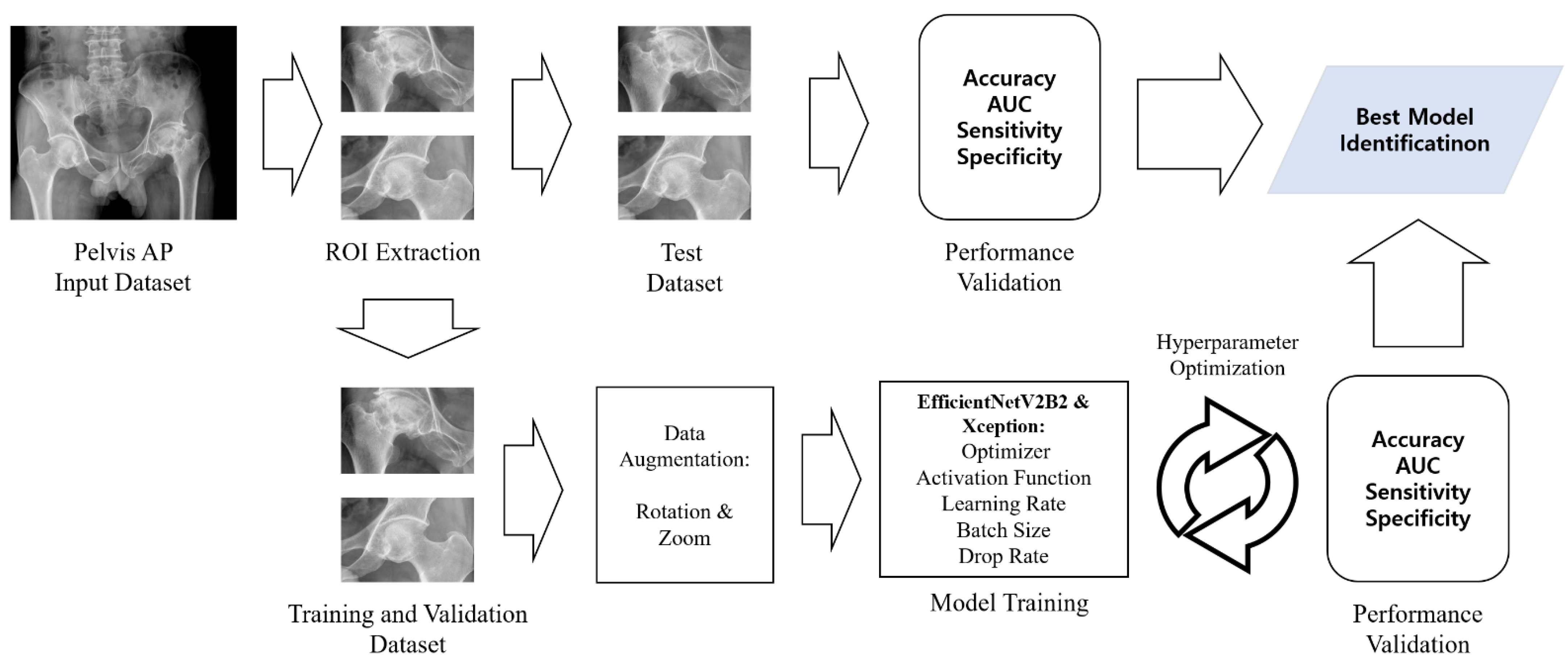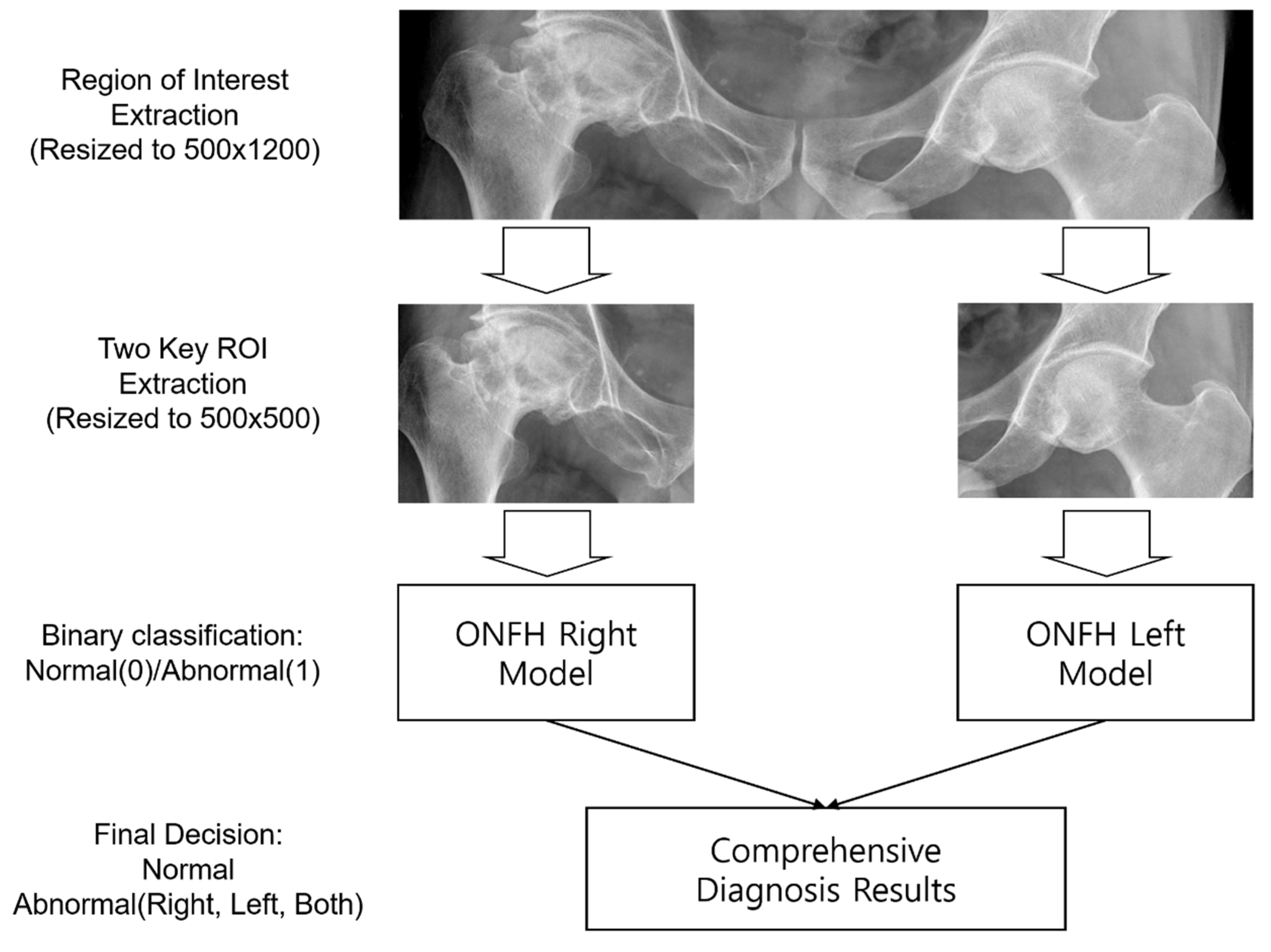Convolutional Neural Network Algorithm Trained with Anteroposterior Radiographs to Diagnose Pre-Collapse Osteonecrosis of the Femoral Head
Abstract
1. Introduction
2. Materials and Methods
2.1. Subjects
2.2. Pelvic Anteroposterior Radiograph and MRI
2.3. Deep Learning Model
2.4. Experiment
2.5. Statistical Analysis
3. Results
4. Discussion
4.1. Overall Performance
4.2. Performance Comparison with Previous Studies
4.3. Limitations
5. Conclusions
Author Contributions
Funding
Institutional Review Board Statement
Informed Consent Statement
Data Availability Statement
Conflicts of Interest
References
- Hines, J.T.; Jo, W.L.; Cui, Q.; Mont, M.A.; Koo, K.H.; Cheng, E.Y.; Goodman, S.B.; Ha, Y.C.; Hernigou, P.; Jones, L.C.; et al. Osteonecrosis of the Femoral Head: An Updated Review of ARCO on Pathogenesis, Staging and Treatment. J. Korean Med. Sci. 2021, 36, e177. [Google Scholar] [CrossRef] [PubMed]
- Chee, C.G.; Cho, J.; Kang, Y.; Kim, Y.; Lee, E.; Lee, J.W.; Ahn, J.M.; Kang, H.S. Diagnostic accuracy of digital radiography for the diagnosis of osteonecrosis of the femoral head, revisited. Acta Radiol. 2019, 60, 969–976. [Google Scholar] [CrossRef] [PubMed]
- Fordyce, M.J.; Solomon, L. Early detection of avascular necrosis of the femoral head by MRI. J. Bone Joint Surg. Br. 1993, 75, 365–367. [Google Scholar] [CrossRef] [PubMed]
- Choi, H.R.; Steinberg, M.E.; Cheng, E.Y. Osteonecrosis of the femoral head: Diagnosis and classification systems. Curr. Rev. Musculoskelet. Med. 2015, 8, 210–220. [Google Scholar] [CrossRef]
- Zhao, D.; Zhang, F.; Wang, B.; Liu, B.; Li, L.; Kim, S.Y.; Goodman, S.B.; Hernigou, P.; Cui, Q.; Lineaweaver, W.C.; et al. Guidelines for clinical diagnosis and treatment of osteonecrosis of the femoral head in adults (2019 version). J. Orthop. Translat. 2020, 21, 100–110. [Google Scholar] [CrossRef]
- Kim, J.K.; Choo, Y.J.; Choi, G.S.; Shin, H.; Chang, M.C.; Park, D. Deep Learning Analysis to Automatically Detect the Presence of Penetration or Aspiration in Videofluoroscopic Swallowing Study. J. Korean Med. Sci. 2022, 37, e42. [Google Scholar] [CrossRef] [PubMed]
- Kim, J.K.; Choo, Y.J.; Shin, H.; Choi, G.S.; Chang, M.C. Prediction of ambulatory outcome in patients with corona radiata infarction using deep learning. Sci. Rep. 2021, 11, 7989. [Google Scholar] [CrossRef]
- Lundervold, A.S.; Lundervold, A. An overview of deep learning in medical imaging focusing on MRI. Z. Med. Phys. 2019, 29, 102–127. [Google Scholar] [CrossRef]
- Sejnowski, T.J. The unreasonable effectiveness of deep learning in artificial intelligence. Proc. Natl. Acad. Sci. USA 2020, 117, 30033–30038. [Google Scholar] [CrossRef]
- Jiang, F.; Jiang, Y.; Zhi, H.; Dong, Y.; Li, H.; Ma, S.; Wang, Y.; Dong, Q.; Shen, H.; Wang, Y. Artificial intelligence in healthcare: Past, present and future. Stroke. Vasc. Neurol. 2017, 2, 230–243. [Google Scholar] [CrossRef]
- Yamashita, R.; Nishio, M.; Do, R.K.G.; Togashi, K. Convolutional neural networks: An overview and application in radiology. Insights Imaging 2018, 9, 611–629. [Google Scholar] [CrossRef]
- Kim, J.K.; Chang, M.C.; Park, D. Deep Learning Algorithm Trained on Brain Magnetic Resonance Images and Clinical Data to Predict Motor Outcomes of Patients with Corona Radiata Infarct. Front. Neurosci. 2021, 15, 795553. [Google Scholar] [CrossRef]
- O’Shea, K.; Nash, R. An introduction to convolutional neural networks. arXiv 2015, arXiv:1511.08458. [Google Scholar]
- Marques, G.; Agarwal, D.; de la Torre Díez, I. Automated medical diagnosis of COVID-19 through EfficientNet convolutional neural network. Appl. Soft Comput. 2020, 96, 106691. [Google Scholar] [CrossRef]
- Doerr, S.A.; Weber-Levine, C.; Hersh, A.M.; Awosika, T.; Judy, B.; Jin, Y.; Raj, D.; Liu, A.; Lubelski, D.; Jones, C.K.; et al. Automated prediction of the Thoracolumbar Injury Classification and Severity Score from CT using a novel deep learning algorithm. J. Orthop. Sci. 2022, 52, E5. [Google Scholar] [CrossRef]
- Ouyang, H.; Meng, F.; Liu, J.; Song, X.; Li, Y.; Yuan, Y.; Wang, C.; Lang, N.; Tian, S.; Yao, M.; et al. Evaluation of Deep Learning-Based Automated Detection of Primary Spine Tumors on MRI Using the Turing Test. Front. Oncol. 2022, 12, 814667. [Google Scholar] [CrossRef]
- Tao, J.; Wang, Y.; Liang, Y.; Zhang, A. Evaluation and Monitoring of Endometrial Cancer Based on Magnetic Resonance Imaging Features of Deep Learning. Contrast Media Mol. Imaging 2022, 2022, 5198592. [Google Scholar] [CrossRef]
- Tan, M.; Le, Q. EfficientNetV2: Smaller Models and Faster Training. In Proceedings of the 38th International Conference on Machine Learning, Virtual. 18–24 July 2021; pp. 10096–10106. [Google Scholar]
- Chollet, F. Xception: Deep Learning with Depthwise Separable Convolutions. In Proceedings of the 2017 IEEE Conference on Computer Vision and Pattern Recognition (CVPR), Honolulu, HI, USA, 21–26 July 2017; pp. 1800–1807. [Google Scholar]
- DeLong, E.R.; DeLong, D.M.; Clarke-Pearson, D.L. Comparing the areas under two or more correlated receiver operating characteristic curves: A nonparametric approach. Biometrics 1988, 44, 837–845. [Google Scholar] [CrossRef]
- Mandrekar, J.N. Receiver operating characteristic curve in diagnostic test assessment. J. Thorac. Oncol. 2010, 5, 1315–1316. [Google Scholar] [CrossRef]
- Chee, C.G.; Kim, Y.; Kang, Y.; Lee, K.J.; Chae, H.D.; Cho, J.; Nam, C.M.; Choi, D.; Lee, E.; Lee, J.W.; et al. Performance of a Deep Learning Algorithm in Detecting Osteonecrosis of the Femoral Head on Digital Radiography: A Comparison with Assessments by Radiologists. Am. J. Roentgenol. 2019, 213, 155–162. [Google Scholar] [CrossRef]
- Li, Y.; Li, Y.; Tian, H. Deep Learning-Based End-to-End Diagnosis System for Avascular Necrosis of Femoral Head. IEEE J. Biomed. Health Inform. 2021, 25, 2093–2102. [Google Scholar] [CrossRef]
- Petek, D.; Hannouche, D.; Suva, D. Osteonecrosis of the femoral head: Pathophysiology and current concepts of treatment. EFFORT Open Rev. 2019, 4, 85–97. [Google Scholar] [CrossRef]





| ONFH (Right Hip) Diagnosis Model | ONFH (Left Hip) Diagnosis Model | |
|---|---|---|
| Sample size (patients) | 213 for training (69.8%), 64 for validation (21.0%), and 28 for test (9.2%) | 213 for training (69.8%), 64 for validation (21.0%), and 28 for test (9.2%) |
| Sample ratio: normal 74.2%, ONFH 25.8% | Sample ratio: normal 79.8%, ONFH 20.2% | |
| CNN model | EfficientNetV2B2 with fine-tuning (Unfreeze top 3 layers) [18] | Xception with full training (Unfreeze all layers) [19] |
| RMSProp optimizer, ReLU activation | RMSProp optimizer, ReLU activation | |
| Learning rate: 1 × 10−5; batch size: 32 | Learning rate: 1 × 10−5; batch size: 32 | |
| Data augmentation (rotation range: 10°; zoom range 10%) | Data augmentation (rotation range: 10°; zoom range: 10%) | |
| Dropout for regularization | Dropout for regularization | |
| ROI image (500 × 500) resized to 260 × 260 | ROI image (500 × 500) resized to 299 × 299 | |
| Model performance | Accuracy: 100% for training data | Accuracy: 98.6% for training data |
| Training AUC: 1.000 | Training AUC: 0.999 with 95% CI [0.997–1.000] | |
| Validation accuracy: 93.8% for validation data | Validation accuracy: 92.2% for validation data | |
| Validation AUC: 0.927 with 95% CI [0.853–1.000] | Validation AUC: 0.893 with 95% CI [0.784–1.000] | |
| Test accuracy: 89.3% for test data | Test accuracy: 92.9% for test data | |
| Test AUC: 0.912 with 95% CI [0.773–1.000] | Test AUC: 0.902 with 95% CI [0.747–1.000] |
| ONFH (Right Hip) Diagnosis Model | ONFH (Left Hip) Diagnosis Model | ||||
|---|---|---|---|---|---|
| Layer (Type) | Output Shape | Param # | Layer (Type) | Output Shape | Param # |
| Efficient-NetV2B2 (model, unfreeze only last 3 layers) | 9 × 9 × 1408 | 292,864 | Xception (model) | 10 × 10 × 2048 | 3,159,552 |
| Global_average_poolong_2d | 1408 | 0 | Global_average_poolong_2d | 2048 | 0 |
| Dropout (dropout) | 1408 | 0 | Dropout (dropout) | 2048 | 0 |
| Dense (dense) | 1 | 1409 | Dense (dense) | 1 | 2049 |
| Total params: 8,770,783 Trainable params: 297,089 Non-trainable params: 8,473,694 | Total params: 20,863,529 Trainable params: 20,809,001 Non-trainable params: 54,528 | ||||
| AUC | Sensitivity | Specificity | |
|---|---|---|---|
| ONFH right hip model | 0.912 (CI 0.773–1.0) | 0.857 (CI 0.487–0.974) | 0.905 (CI 0.711–0.974) |
| ONFH left hip model | 0.902 (CI 0.747–1.0) | 0.667 (CI 0.300–0.903) | 1.000 |
| Chee et al. [22] | 0.930 (CI N/A) | 0.848 (CI 0.733–0.906) | 0.913 (CI 0.720–0.989) |
| Li et al. [23] | 0.974 (CI 0.971–0.978) | 0.900 (CI 0.877–0.923) | 0.946 (CI 0.937–0.955) |
Publisher’s Note: MDPI stays neutral with regard to jurisdictional claims in published maps and institutional affiliations. |
© 2022 by the authors. Licensee MDPI, Basel, Switzerland. This article is an open access article distributed under the terms and conditions of the Creative Commons Attribution (CC BY) license (https://creativecommons.org/licenses/by/4.0/).
Share and Cite
Kim, J.K.; Choi, G.-S.; Kwak, S.Y.; Chang, M.C. Convolutional Neural Network Algorithm Trained with Anteroposterior Radiographs to Diagnose Pre-Collapse Osteonecrosis of the Femoral Head. Appl. Sci. 2022, 12, 9606. https://doi.org/10.3390/app12199606
Kim JK, Choi G-S, Kwak SY, Chang MC. Convolutional Neural Network Algorithm Trained with Anteroposterior Radiographs to Diagnose Pre-Collapse Osteonecrosis of the Femoral Head. Applied Sciences. 2022; 12(19):9606. https://doi.org/10.3390/app12199606
Chicago/Turabian StyleKim, Jeoung Kun, Gyu-Sik Choi, Seong Yeob Kwak, and Min Cheol Chang. 2022. "Convolutional Neural Network Algorithm Trained with Anteroposterior Radiographs to Diagnose Pre-Collapse Osteonecrosis of the Femoral Head" Applied Sciences 12, no. 19: 9606. https://doi.org/10.3390/app12199606
APA StyleKim, J. K., Choi, G.-S., Kwak, S. Y., & Chang, M. C. (2022). Convolutional Neural Network Algorithm Trained with Anteroposterior Radiographs to Diagnose Pre-Collapse Osteonecrosis of the Femoral Head. Applied Sciences, 12(19), 9606. https://doi.org/10.3390/app12199606







